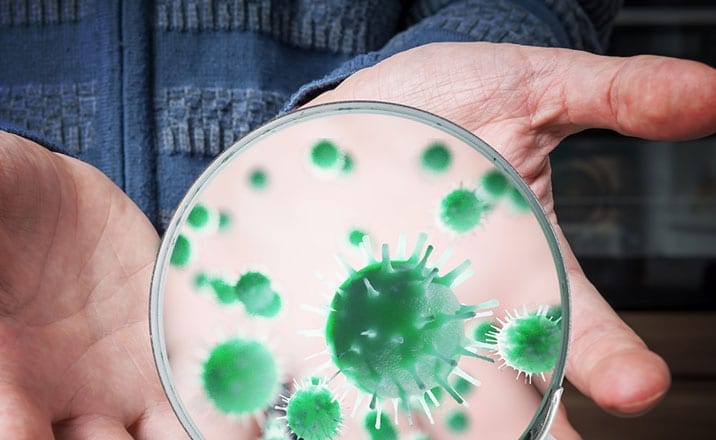Kesan Ozon Terhadap Patogen
By Adminnn • April 24, 2020
Ozone Effects on Specific Bacteria, Viruses and Molds
Bacteria are microscopically small, single-cell creatures having a primitive structure. The bacteria body is sealed by a relatively solid cell membrane. Ozone interferes with the metabolism of bacterium-cells, most likely through inhibiting and blocking the operation of the enzymatic control system. A sufficient amount of ozone breaks through the cell membrane and this leads to the destruction of the bacteria.
Viruses are small, independent particles, built of crystals and macromolecules. Unlike bacteria, they multiply only within the host cell. They transform the protein of the host cell into proteins of their own. Ozone destroys most viruses by diffusing through the protein coat into the nucleic acid core, resulting in damage of the viral RNA. At higher concentrations, ozone destroys the capsid, or exterior protein shell, by oxidation, so the DNA (deoxyribonucleic acid) or RNA (ribonucleic acid) structures of the microorganism are affected.
PATHOGEN
DOSAGE
Aspergillus Niger (Black Mount)
Destroyed by 1.5 to 2 mg/I
Bacillus Bacteria
Destroyed by 0.2 m/I within 30 seconds
Bacillus Anthracis (causes anthrax in sheep, cattle and pigs. Also a human pathogen)
Ozone susceptible
Bacillus cereus
99% destruction after 5-min at 0.12 mg/l in water
B. cereus (spores)
99% destruction after 5-min at 2.3 mg/l in water
Bacillus subtilis
90% reduction at 0.10-ppm for 33 minutes
Bacteriophage f2
99.99% destruction at 0.41 mg/l for 10-seconds in water
Botrytis cinerea
3.8 mg/l for 2 minutes
Candida Bacteria
Ozone susceptible
Clavibacter michiganense
99.99% destruction at 1.1 mg/l for 5 minutes
Cladosporium
90% reduction at 0.10-ppm for 12.1 minutes
Clostridium Bacteria
Ozone susceptible
Clostridium Botulinum Spores. Its toxin paralyzes the central nerve system, being a poison multiplying in food and meals.
0.4 to 0.5 mg/l threshold value
Coxsackie Virus A9
95% destruction at 0.035 mg/l for 10-seconds in water
Coxsackie Virus B5
99.99% destruction at 0.4 mg/l for 2.5-minutes in sludge effluent
Diphtheria Pathogen
Destroyed by 1.5 to 2 mg/l
Eberth Bacillus (Typhus abdomanalis). Spreads typically by aqueous infection and causes typhoid.
Destroyed by 1.5 to 2 mg/l
Echo Virus 29: The virus most sensitive to ozone.
After a contact time of 1 minute at 1 mg/l of ozone, 99.999% killed.
Enteric virus
95% destruction at 4.1 mg/l for 29 minutes in raw wastewater
Escherichia Coli Bacteria (from feces)
Destroyed by 0.2 mg/l within 30 seconds in air
E-coli (in clean water)
99.99% destruction at 0.25 mg/l for 1.6 minutes
E-coli (in wastewater)
99.9% destruction at 2.2 mg/l for 19 minutes
Encephalomyocarditis Virus
Destroyed to zero level in less than 30 seconds with 0.1 to 0.8 mg/l.
Endamoebic Cysts Bacteria
Ozone susceptible
Enterovirus Virus
Destroyed to zero level in less than 30 seconds with 0.1 to 0.8 mg/l.
Fusarium oxysporum f.sp. lycopersici
1.1 mg/l for 10 minutes
Fusarium oxysporum f.sp. melonogea
99.99 % destruction at 1.1 mg/l for 20 minutes
GDVII Virus
Destroyed to zero level in less than 30 seconds with 0.1 to 0.8 mg/l.
Hepatitis A virus
99.5% reduction at 0.25 mg/l for 2-seconds in a phosphate buffer
Herpes Virus
Destroyed to zero level in less than 30 seconds wit 0.1 to 0.8 mg/l.
Influenza Virus
0.4 to 0.5 mg/l threshold value
Klebs-Loffler Bacillus
Destroyed by 1.5 to 2 mg/l
Legionella pneumophila
99.99% destruction at 0.32 mg/l for 20 minutes in distilled water
Luminescent Basidiomycetes (species having no melanin pigment).
Destroyed in 10 minutes at 100-ppm
Mucor piriformis
3.8 mg/l for 2 minutes
Mycobacterium avium
99.9% with a CT value of 0.17 in water
Mycobacterium foruitum
90% destruction at 0.25 mg/l for 1.6 minutes in water
Penicillium Bacteria
Ozone susceptible
Phytophthora parasitica
3.8 mg/l for 2 minutes
Poliomyelitis Virus
99.99% kill with 0.3 to 0.4 mg/l in 3-4 minutes
Poliovirus type 1
99.5% destruction at 0.25 mg/l for 1.6 minutes in water
Proteus Bacteria
Very susceptible
Pseudomonas Bacteria
Very susceptible
Rhabdovirus virus
Destroyed to zero level in less than 30 seconds with 0.1 to 0.8 mg/l
Salmonella Bacteria
Very susceptible
Salmonella typhimurium
99.99% destruction at 0.25 mg/l for 1.67 minutes in water
Schistosoma Bacteria
Very susceptible
Staph epidermidis
90% reduction at 0.1-ppm for 1.7 min
Staphylococci
Destroyed by 1.5 to 2.0 mg/l
Stomatitis Virus
Destroyed to zero level in less than 30 seconds with 0.1 to 0.8 mg/l
Streptococcus Bacteria
Destroyed by 0.2 mg/l within 30 seconds
Verticillium dahliae
99.99 % destruction at 1.1 mg/l for 20 minutes
Vesicular Virus
Destroyed to zero level in less than 30 seconds with 0.1 to 0.8 mg/l
Virbrio Cholera Bacteria
Very susceptible
Vicia Faba progeny
Ozone causes chromosome aberration and its effect is twice that observed by the action of X-rays
The effect of ozone below a certain critical concentration value is small or zero. Above this level all pathogens are eventually destroyed. This effect is called an “all-or-none response” and the critical level is called the “threshold value.”
Ozone Effects on Specific Bacteria, Viruses and Molds
Bacteria are microscopically small, single-cell creatures having a primitive structure. The bacteria body is sealed by a relatively solid cell membrane. Ozone interferes with the metabolism of bacterium-cells, most likely through inhibiting and blocking the operation of the enzymatic control system. A sufficient amount of ozone breaks through the cell membrane and this leads to the destruction of the bacteria.
Viruses are small, independent particles, built of crystals and macromolecules. Unlike bacteria, they multiply only within the host cell. They transform the protein of the host cell into proteins of their own. Ozone destroys most viruses by diffusing through the protein coat into the nucleic acid core, resulting in damage of the viral RNA. At higher concentrations, ozone destroys the capsid, or exterior protein shell, by oxidation, so the DNA (deoxyribonucleic acid) or RNA (ribonucleic acid) structures of the microorganism are affected.
| PATHOGEN | DOSAGE |
|---|---|
| Aspergillus Niger (Black Mount) | Destroyed by 1.5 to 2 mg/I |
| Bacillus Bacteria | Destroyed by 0.2 m/I within 30 seconds |
| Bacillus Anthracis (causes anthrax in sheep, cattle and pigs. Also a human pathogen) | Ozone susceptible |
| Bacillus cereus | 99% destruction after 5-min at 0.12 mg/l in water |
| B. cereus (spores) | 99% destruction after 5-min at 2.3 mg/l in water |
| Bacillus subtilis | 90% reduction at 0.10-ppm for 33 minutes |
| Bacteriophage f2 | 99.99% destruction at 0.41 mg/l for 10-seconds in water |
| Botrytis cinerea | 3.8 mg/l for 2 minutes |
| Candida Bacteria | Ozone susceptible |
| Clavibacter michiganense | 99.99% destruction at 1.1 mg/l for 5 minutes |
| Cladosporium | 90% reduction at 0.10-ppm for 12.1 minutes |
| Clostridium Bacteria | Ozone susceptible |
| Clostridium Botulinum Spores. Its toxin paralyzes the central nerve system, being a poison multiplying in food and meals. | 0.4 to 0.5 mg/l threshold value |
| Coxsackie Virus A9 | 95% destruction at 0.035 mg/l for 10-seconds in water |
| Coxsackie Virus B5 | 99.99% destruction at 0.4 mg/l for 2.5-minutes in sludge effluent |
| Diphtheria Pathogen | Destroyed by 1.5 to 2 mg/l |
| Eberth Bacillus (Typhus abdomanalis). Spreads typically by aqueous infection and causes typhoid. | Destroyed by 1.5 to 2 mg/l |
| Echo Virus 29: The virus most sensitive to ozone. | After a contact time of 1 minute at 1 mg/l of ozone, 99.999% killed. |
| Enteric virus | 95% destruction at 4.1 mg/l for 29 minutes in raw wastewater |
| Escherichia Coli Bacteria (from feces) | Destroyed by 0.2 mg/l within 30 seconds in air |
| E-coli (in clean water) | 99.99% destruction at 0.25 mg/l for 1.6 minutes |
| E-coli (in wastewater) | 99.9% destruction at 2.2 mg/l for 19 minutes |
| Encephalomyocarditis Virus | Destroyed to zero level in less than 30 seconds with 0.1 to 0.8 mg/l. |
| Endamoebic Cysts Bacteria | Ozone susceptible |
| Enterovirus Virus | Destroyed to zero level in less than 30 seconds with 0.1 to 0.8 mg/l. |
| Fusarium oxysporum f.sp. lycopersici | 1.1 mg/l for 10 minutes |
| Fusarium oxysporum f.sp. melonogea | 99.99 % destruction at 1.1 mg/l for 20 minutes |
| GDVII Virus | Destroyed to zero level in less than 30 seconds with 0.1 to 0.8 mg/l. |
| Hepatitis A virus | 99.5% reduction at 0.25 mg/l for 2-seconds in a phosphate buffer |
| Herpes Virus | Destroyed to zero level in less than 30 seconds wit 0.1 to 0.8 mg/l. |
| Influenza Virus | 0.4 to 0.5 mg/l threshold value |
| Klebs-Loffler Bacillus | Destroyed by 1.5 to 2 mg/l |
| Legionella pneumophila | 99.99% destruction at 0.32 mg/l for 20 minutes in distilled water |
| Luminescent Basidiomycetes (species having no melanin pigment). | Destroyed in 10 minutes at 100-ppm |
| Mucor piriformis | 3.8 mg/l for 2 minutes |
| Mycobacterium avium | 99.9% with a CT value of 0.17 in water |
| Mycobacterium foruitum | 90% destruction at 0.25 mg/l for 1.6 minutes in water |
| Penicillium Bacteria | Ozone susceptible |
| Phytophthora parasitica | 3.8 mg/l for 2 minutes |
| Poliomyelitis Virus | 99.99% kill with 0.3 to 0.4 mg/l in 3-4 minutes |
| Poliovirus type 1 | 99.5% destruction at 0.25 mg/l for 1.6 minutes in water |
| Proteus Bacteria | Very susceptible |
| Pseudomonas Bacteria | Very susceptible |
| Rhabdovirus virus | Destroyed to zero level in less than 30 seconds with 0.1 to 0.8 mg/l |
| Salmonella Bacteria | Very susceptible |
| Salmonella typhimurium | 99.99% destruction at 0.25 mg/l for 1.67 minutes in water |
| Schistosoma Bacteria | Very susceptible |
| Staph epidermidis | 90% reduction at 0.1-ppm for 1.7 min |
| Staphylococci | Destroyed by 1.5 to 2.0 mg/l |
| Stomatitis Virus | Destroyed to zero level in less than 30 seconds with 0.1 to 0.8 mg/l |
| Streptococcus Bacteria | Destroyed by 0.2 mg/l within 30 seconds |
| Verticillium dahliae | 99.99 % destruction at 1.1 mg/l for 20 minutes |
| Vesicular Virus | Destroyed to zero level in less than 30 seconds with 0.1 to 0.8 mg/l |
| Virbrio Cholera Bacteria | Very susceptible |
| Vicia Faba progeny | Ozone causes chromosome aberration and its effect is twice that observed by the action of X-rays |
The effect of ozone below a certain critical concentration value is small or zero. Above this level all pathogens are eventually destroyed. This effect is called an “all-or-none response” and the critical level is called the “threshold value.”



















